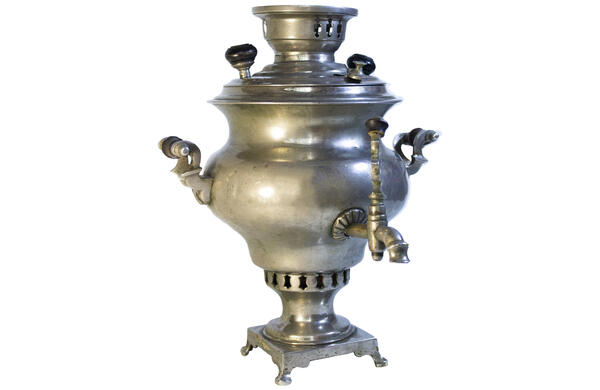In the old days, samovars were made from brass or copper, rarely from silver, and then they were nickel-plated — the surface of the samovar was covered with a thin layer of nickel to provide corrosion resistance. The top part of the samovar, that the water was poured through, was covered with a lid. The base and the faucet to facilitate water flow were attached to the body.
The water inside the samovar was heated from the metal pipe. The top end of the pipe with the crown (a teapot stand that provides airflow) travels through the lid outside the samovar. The bottom end placed near the base was covered with the fire grate.
Hot coals were put into the chimney/jug (a special compartment for the fuel, located at the center of the body of the samovar). The combustion process was maintained with the slots in the upper part of the body and with a bent vent-pipe that was put on top of the chimney. After the water had started boiling, the vent pipe was removed, and the chimney was covered with the cap. To release steam, there was a small round opening with a hinged lid on top of the samovar lid — the steam vent.
Samovar with a teapot appeared around the 17th century when tea drinking became a popular pastime not only in the city but also in the village. Peasants purchased samovars in small country stores and city shops. At large fairs like the Makaryev Fair, the Irbit fair, the Nizhny Novgorod Fair, samovar ‘rows’ were organized where all the items could be bought by the piece and by the kilo. In the 19th — early 20th centuries, only domestically produced samovars were used in Russia. They were made at the factories of Tula, Moscow, Yekaterinburg, and other cities in the Ural region. The brand stamps and the medals the factory received for the items it produced that won in industrial fairs and exhibitions, were stamped onto the samovars.
In the 19th century, almost 80 factories produced their items in Tula. This city was called the samovar capital of Russia. Samovars produced at the factory of the merchant Nikolay Vorontsov were considered the most luxurious ones. Nikolay opened the factory in 1852, and soon after that, almost 6000 samovars were produced there every year. People called the merchant Nikolay Vorontsov ‘the samovar king’. His factory produced almost all the prize-winning items at most of the Russian and overseas exhibitions and fairs.
After Nikolay Vorontsov’s death, the factory passed to his successors. After the nationalization policies had been adopted, the factory was turned into an artel (a cooperative association in Russia). Not long after, the old samovar manufacturing ceased to exist.
The samovar presented in the middle-class hall of the Oryol Local History Museum was also produced at the factory of Nikolay Vorontsov. The oval stamp and the inscription “Vorontsov” on the lid can prove this. The parts of the samovar are decorated with geometrical ornaments.
The water inside the samovar was heated from the metal pipe. The top end of the pipe with the crown (a teapot stand that provides airflow) travels through the lid outside the samovar. The bottom end placed near the base was covered with the fire grate.
Hot coals were put into the chimney/jug (a special compartment for the fuel, located at the center of the body of the samovar). The combustion process was maintained with the slots in the upper part of the body and with a bent vent-pipe that was put on top of the chimney. After the water had started boiling, the vent pipe was removed, and the chimney was covered with the cap. To release steam, there was a small round opening with a hinged lid on top of the samovar lid — the steam vent.
Samovar with a teapot appeared around the 17th century when tea drinking became a popular pastime not only in the city but also in the village. Peasants purchased samovars in small country stores and city shops. At large fairs like the Makaryev Fair, the Irbit fair, the Nizhny Novgorod Fair, samovar ‘rows’ were organized where all the items could be bought by the piece and by the kilo. In the 19th — early 20th centuries, only domestically produced samovars were used in Russia. They were made at the factories of Tula, Moscow, Yekaterinburg, and other cities in the Ural region. The brand stamps and the medals the factory received for the items it produced that won in industrial fairs and exhibitions, were stamped onto the samovars.
In the 19th century, almost 80 factories produced their items in Tula. This city was called the samovar capital of Russia. Samovars produced at the factory of the merchant Nikolay Vorontsov were considered the most luxurious ones. Nikolay opened the factory in 1852, and soon after that, almost 6000 samovars were produced there every year. People called the merchant Nikolay Vorontsov ‘the samovar king’. His factory produced almost all the prize-winning items at most of the Russian and overseas exhibitions and fairs.
After Nikolay Vorontsov’s death, the factory passed to his successors. After the nationalization policies had been adopted, the factory was turned into an artel (a cooperative association in Russia). Not long after, the old samovar manufacturing ceased to exist.
The samovar presented in the middle-class hall of the Oryol Local History Museum was also produced at the factory of Nikolay Vorontsov. The oval stamp and the inscription “Vorontsov” on the lid can prove this. The parts of the samovar are decorated with geometrical ornaments.



